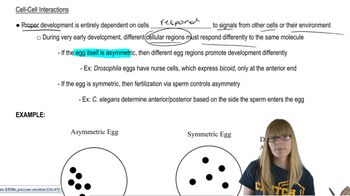Areas with higher bicoid expression will develop into which body pattern?
Table of contents
- 1. Introduction to Genetics51m
- 2. Mendel's Laws of Inheritance3h 37m
- 3. Extensions to Mendelian Inheritance2h 41m
- 4. Genetic Mapping and Linkage2h 28m
- 5. Genetics of Bacteria and Viruses1h 21m
- 6. Chromosomal Variation1h 48m
- 7. DNA and Chromosome Structure56m
- 8. DNA Replication1h 10m
- 9. Mitosis and Meiosis1h 34m
- 10. Transcription1h 0m
- 11. Translation58m
- 12. Gene Regulation in Prokaryotes1h 19m
- 13. Gene Regulation in Eukaryotes44m
- 14. Genetic Control of Development44m
- 15. Genomes and Genomics1h 50m
- 16. Transposable Elements47m
- 17. Mutation, Repair, and Recombination1h 6m
- 18. Molecular Genetic Tools19m
- 19. Cancer Genetics29m
- 20. Quantitative Genetics1h 26m
- 21. Population Genetics50m
- 22. Evolutionary Genetics29m
14. Genetic Control of Development
Developmental Patterning Genes
Problem 1e
Textbook Question
In the discussion, we have focused on large-scale as well as the inter- and intracellular events that take place during embryogenesis and the formation of adult structures. In particular, we discussed how the adult body plan is laid down by a cascade of gene expression, and the role of cell–cell communication in development. Based on your knowledge of these topics, answer several fundamental questions:
How do we know that eye formation in all animals is controlled by a binary switch gene?
 Verified step by step guidance
Verified step by step guidance1
Understand the concept of a binary switch gene: A binary switch gene is a master regulatory gene that controls the development of a specific structure or organ. It acts as a 'switch' to initiate the developmental program for that structure.
Review the evidence supporting the role of binary switch genes in eye formation: Research has shown that the Pax6 gene is conserved across many species and is essential for eye development. Mutations in Pax6 lead to defects in eye formation, demonstrating its critical role.
Examine cross-species studies: Experiments have shown that introducing Pax6 from one species into another can still induce eye formation, indicating that the gene's function is conserved and acts as a binary switch for eye development.
Consider the role of gene expression cascades: Pax6 activates downstream genes involved in eye development, creating a cascade of gene expression that leads to the formation of the eye structure. This supports the idea of Pax6 as a master regulator.
Analyze cell–cell communication in development: During embryogenesis, Pax6 interacts with signaling pathways and other genes to coordinate the development of the eye. This highlights the importance of both genetic and cellular interactions in the process.
 Verified video answer for a similar problem:
Verified video answer for a similar problem:This video solution was recommended by our tutors as helpful for the problem above
Video duration:
28sPlay a video:
Was this helpful?
Key Concepts
Here are the essential concepts you must grasp in order to answer the question correctly.
Binary Switch Genes
Binary switch genes are regulatory genes that control the expression of other genes in a developmental pathway, often determining the presence or absence of specific structures. In the context of eye formation, these genes can toggle between two states, leading to the activation of a cascade of downstream genes that promote eye development. This concept is crucial for understanding how a single genetic switch can influence complex developmental processes across different species.
Recommended video:
Guided course

Mapping Genes
Conservation of Developmental Pathways
The conservation of developmental pathways refers to the phenomenon where similar genetic mechanisms are preserved across diverse species throughout evolution. This suggests that fundamental processes, such as eye formation, are regulated by analogous genes in different organisms. Studying these conserved pathways helps scientists understand the evolutionary relationships and functional similarities in developmental biology.
Recommended video:
Guided course

Repair Pathways
Cell-Cell Communication in Development
Cell-cell communication is essential during embryogenesis, as it allows cells to coordinate their activities and respond to signals from neighboring cells. This interaction is crucial for the proper formation of tissues and organs, including the eyes. Understanding how cells communicate and influence each other's fate is key to deciphering the complex processes that lead to the establishment of the body plan and organogenesis.
Recommended video:
Guided course

Cell-cell interactions
Related Videos
Related Practice
Multiple Choice
431
views
1
rank


